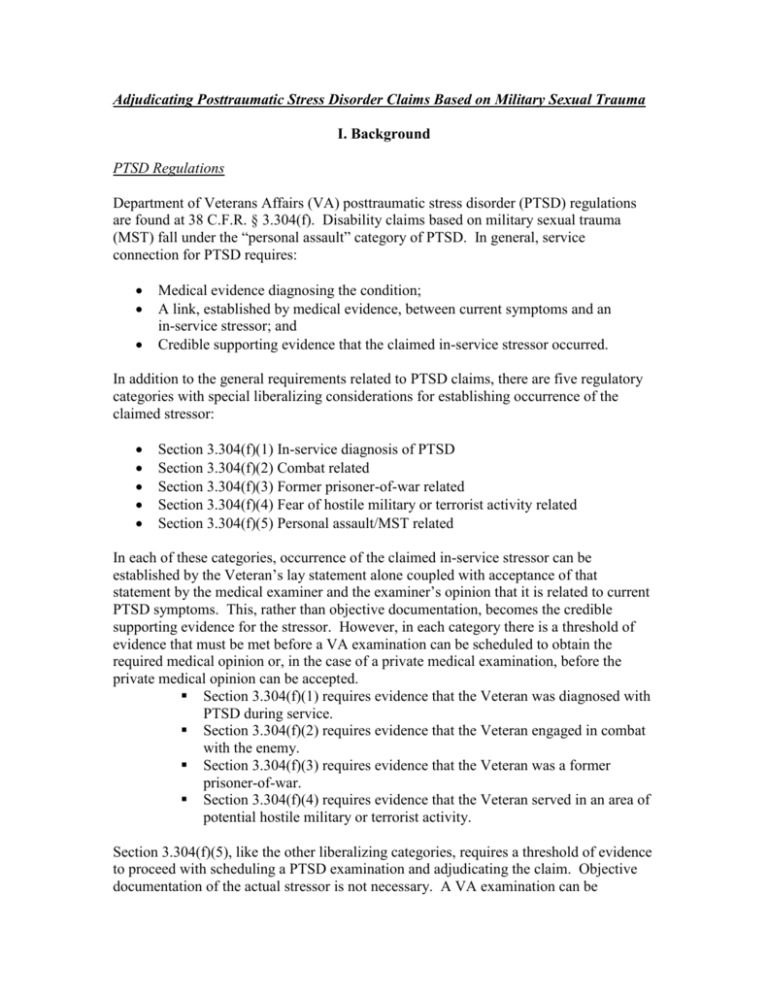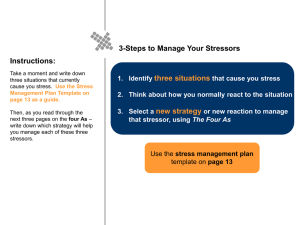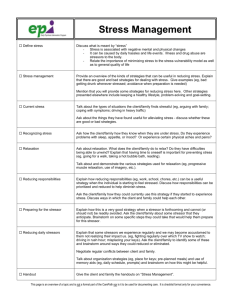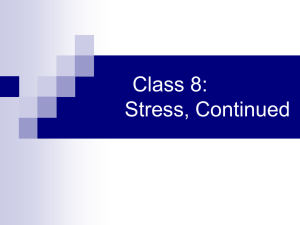
Adjudicating Posttraumatic Stress Disorder Claims Based on Military Sexual Trauma
I. Background
PTSD Regulations
Department of Veterans Affairs (VA) posttraumatic stress disorder (PTSD) regulations
are found at 38 C.F.R. § 3.304(f). Disability claims based on military sexual trauma
(MST) fall under the “personal assault” category of PTSD. In general, service
connection for PTSD requires:
Medical evidence diagnosing the condition;
A link, established by medical evidence, between current symptoms and an
in-service stressor; and
Credible supporting evidence that the claimed in-service stressor occurred.
In addition to the general requirements related to PTSD claims, there are five regulatory
categories with special liberalizing considerations for establishing occurrence of the
claimed stressor:
Section 3.304(f)(1) In-service diagnosis of PTSD
Section 3.304(f)(2) Combat related
Section 3.304(f)(3) Former prisoner-of-war related
Section 3.304(f)(4) Fear of hostile military or terrorist activity related
Section 3.304(f)(5) Personal assault/MST related
In each of these categories, occurrence of the claimed in-service stressor can be
established by the Veteran’s lay statement alone coupled with acceptance of that
statement by the medical examiner and the examiner’s opinion that it is related to current
PTSD symptoms. This, rather than objective documentation, becomes the credible
supporting evidence for the stressor. However, in each category there is a threshold of
evidence that must be met before a VA examination can be scheduled to obtain the
required medical opinion or, in the case of a private medical examination, before the
private medical opinion can be accepted.
Section 3.304(f)(1) requires evidence that the Veteran was diagnosed with
PTSD during service.
Section 3.304(f)(2) requires evidence that the Veteran engaged in combat
with the enemy.
Section 3.304(f)(3) requires evidence that the Veteran was a former
prisoner-of-war.
Section 3.304(f)(4) requires evidence that the Veteran served in an area of
potential hostile military or terrorist activity.
Section 3.304(f)(5), like the other liberalizing categories, requires a threshold of evidence
to proceed with scheduling a PTSD examination and adjudicating the claim. Objective
documentation of the actual stressor is not necessary. A VA examination can be
scheduled and a medical opinion requested when there is evidence of a “marker” found in
service records or post-service records indicating that the stressor may have occurred.
Markers include evidence of certain types of reports, lay statements, or behavioral
changes that can be associated with the approximate time frame of the claimed stressor.
The acceptance of markers as sufficient evidence to proceed with the VA examination
and claim adjudication is based on the fact that MST victims often do not directly report
or document the stressor at the time it occurs. As a result, evidence must be sought that is
indirect, secondary, or circumstantial in nature. Such evidence can reasonably be
associated with occurrence of the claimed MST stressor. Markers will be explained in
detail in another section of this training letter.
Statutory Definition of MST
The term “military sexual trauma” entered the VA lexicon through the enactment of 38
U.S.C. § 1720D [Counseling and treatment for sexual trauma]. This Veterans Health
Administration statute sets standards for MST treatment and also defines the term. It
refers to: “psychological trauma, which in the judgment of a mental health professional
employed by the Department, resulted from a physical assault of a sexual nature, battery
of a sexual nature, or sexual harassment which occurred while the veteran was serving on
active duty or active duty for training.” It further defines “sexual harassment” as
“repeated, unsolicited verbal or physical contact of a sexual nature which is threatening in
character.” This definition is suitable for use by the Veterans Benefits Administration,
since there is no comparable legal definition other than the broader term “personal
assault” found in PTSD regulations at section 3.304(f)(5).
Related Court Decisions
A number of court cases address the issues involved with adjudicating PTSD claims
based on MST. One major concern for adjudicators is the evidentiary standard to be used
for scheduling a VA examination. Case law from the Court of Appeals for Veterans
Claims (Court), interpreting 38 CFR § 3.159(c)(4) [Providing medical examinations or
obtaining medical opinions], establishes a relatively low threshold for requesting VA
medical examinations. The Court identified four criteria that, when met, require VA to
provide a medical examination. In summary, they are: (1) competent evidence of a
current disability or persistent or recurrent symptoms of a disability, (2) evidence that a
qualifying in-service event occurred, (3) an indication that the disability may be
associated with the Veteran’s service, and (4) insufficient competent medical evidence on
file for a decision on the claim. See McLendon v. Nicholson, 20 Vet.App. 79 (2006).
In PTSD cases related to MST, the first criterion is met with a current medical diagnosis
of PTSD or the Veteran’s lay statements describing PTSD symptoms. The second
criterion is met when there is some evidence of a marker in the service or post service
records. The third criterion involves a low threshold and liberal approach to recognizing
that only an indication is required that the disability may be associated with the claimed
MST stressor. This indication is established by virtue of a current diagnosis or symptoms
and the presence of a marker. The final criterion is met when there is insufficient
2
evidence to make an informed decision on the claim without the examination. This
would almost always be the case in these claims because the marker itself has not
established occurrence of the stressor and the opinion of the qualified examiner can
provide credible and probative evidence to make that determination.
Another important holding from the Court addressed a PTSD claim based on MST and
served as the basis for the current personal assault regulations. See Patton v. West, 12
Vet.App. 272 (1999). In Patton, the Veteran filed a 1993 claim for PTSD based on an
MST event that occurred while on active duty during 1959. The Veteran had previously
filed a 1979 claim for a “nervous condition” and was denied service connection. From
that time onward his records showed a history of treatment for mental disorders and
alcoholism. The 1993 PTSD claim was denied and the denial upheld by the Board of
Veterans Appeals (BVA) based on insufficient evidence of an in-service stressor.
Subsequently, the Court vacated the BVA decision and remanded for further
development consistent with its opinion. The opinion centered on the fact that BVA did
not address the personal assault development procedures contained in the 1996 VA
Adjudication Procedure Manual M21-1. The Court considered these procedures to be
“substantive rules” equivalent to VA regulations and, therefore, BVA was obligated to
address them in the reasons and bases for its decision. This holding led to the 2002
creation of the current PTSD regulations in section 3.304(f)(5).
The Court stressed that the M21-1 Manual required a special obligation on VA’s part to
assist claimants. This involved two main aspects of evidentiary development. One
aspect is that behavior changes occurring at the time of the incident may indicate the
occurrence of an in-service stressor. The other is that evidence documenting such
behavior changes may require interpretation by a qualified clinician regarding its
relationship to a medical diagnosis. Evidence in this particular case showed that the
Veteran, who had no prior history of mental disorders, was admitted to an Army hospital
emergency room in December 1959 and treated for an acute anxiety reaction. Service
treatment records showed that other soldiers in the barracks reported he had “some sort of
attack.” His military performance subsequently deteriorated with emotional instability
and diffuse anxiety and he was administratively separated from service in 1960. In
addition to this marker, when the Veteran filed the initial claim in 1979, his wife
submitted a letter that described his long-standing emotional and alcohol problems and
also stated that the Veteran’s mother communicated to her that in 1961 “she was afraid
the Veteran would kill himself” and that “something had happened to him in service.”
The Court determined that, although there was no direct evidence of a MST stressor,
these signs of behavior change were sufficient to trigger a VA exam so that a qualified
clinician could provide an informed interpretation of the behavior changes and an opinion
regarding their relationship to current PTSD symptoms.
Additionally, the Court recognized that a qualified examiner’s opinion can be considered
credible supporting evidence for occurrence of the MST stressor. It held that the general
rule, which states that an examiner’s post-service opinion cannot be used as evidence for
occurrence of the in-service stressor in PTSD claims, does not apply to PTSD claims
involving MST.
3
In summary, the Court stated that “because of the unique problems of documenting
personal-assault claims, the RO is responsible for assisting the claimant in gathering,
from sources in addition to in-service records, evidence corroborating an in-service
stressor, by sending a special letter and questionnaire, by carefully evaluating that
evidence including behavior changes, and by furnishing a clinical evaluation of behavior
evidence.”
II. Claims Processing
Development
Evidentiary development must proceed with the special requirements of section
3.304(f)(5) in mind. This includes providing written notice to the Veteran that: “evidence
from sources other than the Veteran’s service records or evidence of behavior changes
may constitute credible supporting evidence of the stressor and allowing him or her the
opportunity to furnish this type of evidence or advise VA of potential sources of such
evidence.” In some cases, credible evidence supporting occurrence of MST or other
personal assault may already exist in the file. If not, a PIES O18 request should be
initiated to obtain the veteran’s complete military records. If the Veteran identifies a
source of evidence that may support the claim, every reasonable effort should be made to
obtain that evidence. The stigma associated with reporting MST has diminished
somewhat in recent years as the Department of Defense, and US society in general, has
become more aware of the problem. Evidence of MST stressors in claims from recently
separated Veterans may be easier to obtain because of the introduction of DD Form 2910
[Victim Reporting Preference Statement], DD Form 2911 [Forensic Medical Report:
Sexual Assault Examination], and similar forms that can directly corroborate the stressor.
Evidence development related to these forms is explained in Compensation Service Fast
Letter 10-26, Corroborating Military Sexual Trauma (MST) Using DD Form 2910,
Victim Reporting Preference Statement, or Similar Forms, released July 15, 2010.
Markers and VA PTSD Examinations
The term “marker” refers to evidentiary signs, events, or circumstances indicating a
possibility that the claimed stressor occurred. The requirement for seeking markers, as a
first step toward stressor corroboration, represents an acknowledgement by VA of the
special difficulties involved with verifying the required stressor in many MST and other
personal assault claims. This is especially true with PTSD claims filed many years after
separation from service and ones based on a service period when MST reporting was
stigmatized. Section 3.304(f)(5) establishes two categories of markers: those involving
“records” other than service records, and “behavior changes” occurring during service or
at some credible point following service.
Sources of records include, but are not limited to:
Law enforcement authorities,
Rape crisis centers,
4
Mental health counseling centers,
Hospitals,
Physicians,
Pregnancy tests,
Tests for sexually transmitted diseases,
Statements from:
Family members,
Roommates,
Fellow service members,
Clergy members.
Manifestations of behavior changes include, but are not limited to:
Requests for transfer to another military duty assignment,
Deterioration in work performance,
Substance abuse,
Episodes of depression, panic attacks, or anxiety without an identifiable cause,
Unexplained economic or social behavior changes.
All available evidence should be reviewed for these or similar evidentiary markers. A
liberal and open-minded approach should be applied during this review. Any marker
appearing during the approximate time frame of the claimed MST stressor will be
sufficient to go forward with scheduling a VA examination and requesting a clinician’s
opinion as to whether the marker can be associated with occurrence of a stressor and, if
so, whether current PTSD symptoms are related to that in-service stressor.
As a practical matter, in cases filed many years after service, reports from law
enforcement authorities and medical treatment centers that were produced during the time
frame of the in-service MST stressor are difficult to obtain. In these cases, behavioral
changes take on added significance. An important source for discovering such changes is
the periodic performance evaluations found in many service records. These document
the efficiency with which service members carried out their duties. If performance
evaluations decline during the time frame of the claimed stressor, that is sufficient
evidence of a marker and a VA PTSD examination should be scheduled. Likewise, any
document indicating disciplinary action or special treatment is indicative of a marker and
requires a PTSD examination. In some rare cases, an unusual increase in performance
during the time frame of the claimed stressor could indicate an overcompensation
reaction and be sufficient to schedule the PTSD exam. The main point is that any sign of
behavioral changes during the claimed stressor’s time frame is sufficient to schedule the
PTSD exam and request an opinion.
Behavioral changes occurring after service can also constitute markers, if they can
reasonably be associated with a claimed in-service stressor. Private medical records
showing treatment for mental disorders or substance abuse during the immediate years
following service can indicate emotional reactions resulting from an in-service MST
stressor as long as there is no other significant event documented in the records as the
reason for the treatment. However, treatment for mental disorders many years after
5
service with references to events such as post-service automobile accidents, deaths of
significant others, domestic conflicts, etc. as the cause of the mental disorder, and reason
for treatment, cannot reasonably be associated with the in-service MST stressor and
therefore is not a marker. Unfortunately, there is no bright line test that can be applied
when considering post-service behavioral changes as potential markers. Evidence must
be evaluated on a case-by-case basis and viewed in light of other evidence associated
with the claim.
When seeking valid markers, special attention should be paid to records of lay statements
because the probative value of such statements may vary widely. Section 3.304(f)(5)
includes lay statements as markers when received from family members, roommates,
fellow service members, and clergy members. Ideally, records of these lay statements
would have been produced during the time frame of the claimed stressor, as a written
document or as reported to someone else. Contemporaneous lay statements are clearly
valid markers. Lay statements produced years after the claimed stressor, if they reference
the time frame of the claimed stressor in a credible manner, can also serve as markers. In
Patton, a credible lay statement came from the Veteran’s wife. It was produced years
after the Veteran’s separation from service, at the time he filed his disability claim, but it
referenced statements made by the Veteran’s mother to the wife during the time frame of
the MST stressor. The mother had told the wife of the Veteran’s behavior changes and
emotional problems which occurred shortly after the claimed MST stressor. The Court
found the wife’s lay statement report of this to be probative evidence supporting
occurrence of her husband’s MST. On the other hand, a lay statement produced years
after the Veteran’s separation from service by an acquaintance lacking personal
knowledge of the Veteran’s claimed stressor, or any behavior changes occurring as a
result of it, would have minimal probative value and would not necessarily be considered
a marker. As with post-service behavioral changes, lay statements should be evaluated
on a case-by-case basis and viewed in light of other evidence associated with the claim.
Rating Decisions
The purpose of 38 C.F.R. § 3.304(f)(5) is to recognize the difficulties inherent in
establishing service connection for PTSD claims based on MST, and other personal
assaults, and to provide the basis for a lowered evidentiary standard and a liberal
approach to evaluating these claim. Rating decisions must incorporate and reflect this
intent. All evidence must be weighed in a light most favorable to the Veteran. It is clear
from court cases and the wording of section 3.304(f)(5) that actual documentation of the
claimed stressor is not necessary and that the opinion of a qualified mental health
clinician is credible evidence supporting occurrence of the claimed MST stressor. In the
majority of cases, the clinician’s opinion will be sufficient to grant service connection for
PTSD. However, as stated in the 2002 Federal Register final rule notice establishing the
personal assault PTSD category [67 FR 10330], the decision on service connection
remains with Veterans Benefits Administration raters, not with Veterans Health
Administration medical examiners. The totality of the evidence as it relates to the
Veteran’s credibility must be considered and weighed by the rater. In those cases where
the evidence for and against service connection is approximately equal, or in equipoise,
6
the benefit of doubt must be resolved in favor of the Veteran and service connection
granted.
7





